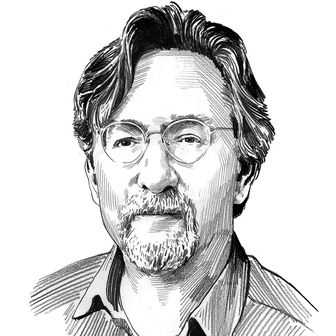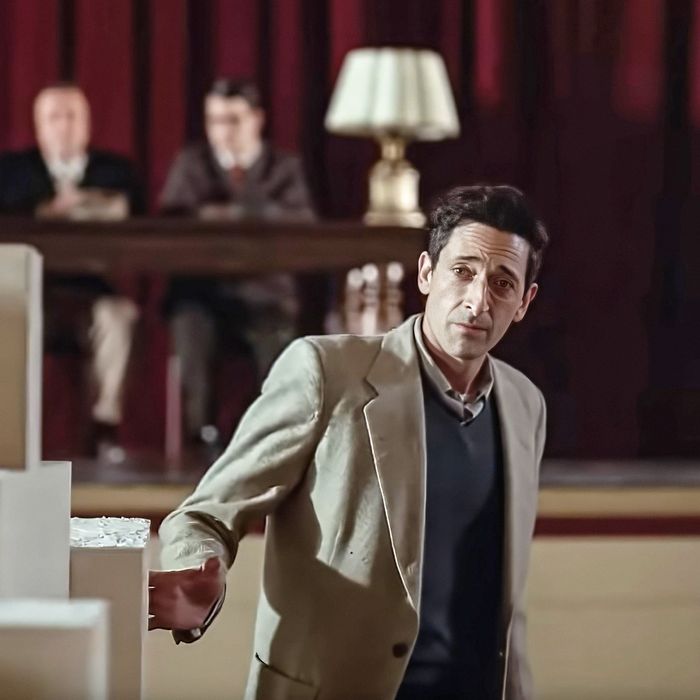
The Brutalist is about architecture in the way that Citizen Kane is about sledding. The entire epic works its way toward a glimmering reveal, the essential metaphor of America expressed in a single artifact. But we’re not asked to care whether that object — a building, a sled — is any good, whether it’s well made, or comfortable, or beautiful. It has meaning only as a container for the protagonist’s memory and desire. The opening scene follows Adrien Brody as Lászlo Tóth, a Jewish Hungarian Holocaust survivor with a broken nose but an intact spirit, as he climbs from the bowels of a ship up into the dazzling pallor of New York Harbor. That progression, rising toward the light, is the immigrant’s American rebirth, which he is constantly trying to relive. We see him yank down the curtains of a rich man’s library and (inadvertently) smash the colored-glass skylight, then center a tubular-steel chaise right in the beam of pure white sunshine that pours in. We see him stagger out of a cavern in the quarries of Carrara into the marble-white day. And we watch him at work as an architect, arranging the marriage of stone and sun so that a ray shoots down a concrete shaft, throwing a radiant cross on a chapel’s altar. (Given that the noted antisemite Philip Johnson did the same thing, there’s a joke in there somewhere: When is it okay for a Jewish architect to design a church? When you can make the cross disappear with a wave of the hand.)
But heavy-handed motif-wielding has its limits, and The Brutalist is no Citizen Kane. (Even if Guy Pearce does a passable Orson Welles impression as the plutocrat Harrison Lee Van Buren.) Just as the director, Brady Corbet, sends his protagonist stumbling through an incomprehensible country, from storage closet to bread line to coal pit, he also seems bent on disorienting the audience. The lighting is persistently muddy. Subtitles for Hungarian dialogue often vanish illegibly against a bright ground. Brody and the rest of the cast murmur through Daniel Blumberg’s thickly scored soundtrack. And Felicity Jones, as Tóth’s wife Erzsébet, whispers so sibilantly into a close mic that her lines come out sounding like an open faucet. All this technical murk has its counterpart in the plot: the confused quest to complete a new community center in Doylestown, Pennsylvania. That may seem like an oddly modest goal for a genius — Ayn Rand’s Howard Roark earned his heroic architect stripes with a monumental Manhattan skyscraper, after all — but this is not just a bingo parlor in a midsize town. Van Buren, who commissions the project and calls it the Institute, imagines a whole hilltop campus with a combination auditorium, gym, and chapel designed by his personal architect in the most advanced modern style. The undertaking drains Van Buren’s prodigious bank account and torments the already thoroughly tormented Tóth. It also bares the faults of the architect’s American-born peers. “Everything that is ugly, cruel, stupid — but, most importantly, ugly — is your fault,” he tells a pragmatic, dollar-pinching colleague — the only other architect he ever seems to meet.
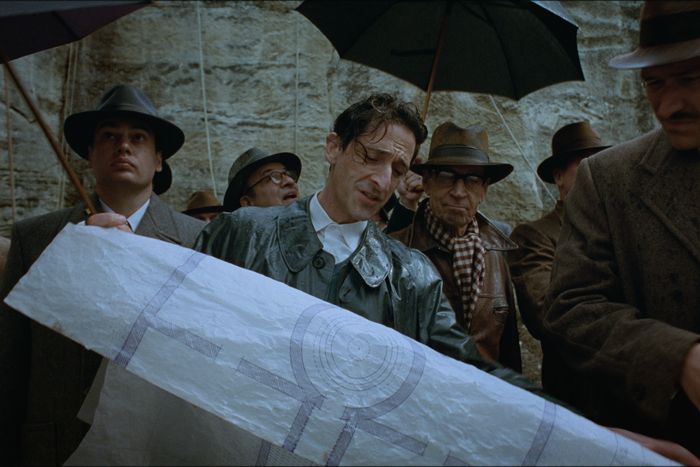
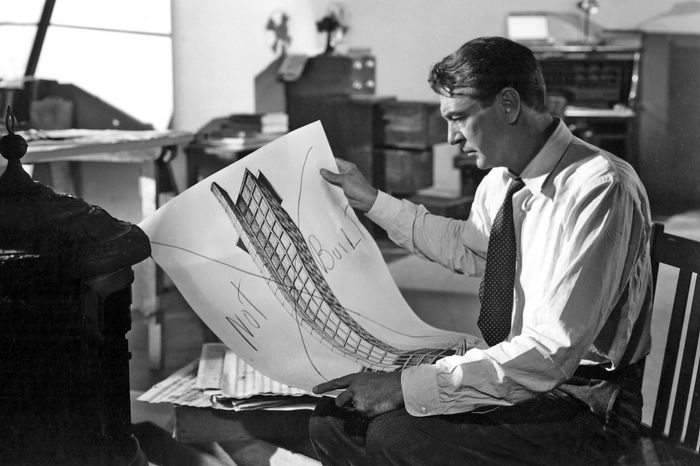
Corbet, the second auteur this year to build a movie around an architectural vision, has created a classic art monster. Like his onscreen colleagues, Howard Roark in The Fountainhead or Jonathan Parker in The Architect, Tóth sacrifices his own happiness and that of everyone around him to the realization of his ideals. You can imagine him excoriating representatives of the other category of film architects, the cuddly (but sometimes also snaky) denim-shirt-wearer of rom-com convention: Tom Hanks in Sleepless in Seattle, William Moses in Mystic Pizza, Liam Neeson in Love, Actually, Steve Martin in It’s Complicated, and many more. And because he’s a dragon-slayer, he must have a dragon to slay: in this case, American mediocrity, always a handy foil for an artistically ambitious filmmaker. Corbet casts Hungary as rural Pennsylvania, and not just because it was cheaper. “It was very important for me to get outside of the U.S. system,” he told The New Yorker’s Alexandra Schwartz. Tóth has had an illustrious prewar career in Budapest, and the effort to revive it in another country, without sacrificing his integrity, nearly destroys him. It’s also a facile narrative device. The Institute, conceived as a massive block of blue-gray concrete with a smokestack-like tower and a series of sepulchre-like chambers, is an overweening symbol of … what? Trauma made solid? Integrity in the face of compromise? The antisocial perversity of postwar modernism? The triumph of the ego? Surely not the foundational principles of the architectural movement called Brutalism (or New Brutalism), which the critic Reyner Banham enumerated in 1955 as “1, formal legibility of plan; 2, clear exhibition of structure, and 3, valuation of materials for their inherent qualities ‘as found.’”
The term Brutalism comes not from an image of aggressive violence but from the French for raw, or crude, as in concrete that’s been left unpolished and bare, or art that’s free of academic refinements. In architecture, it was never an outsider movement; rather, the austere style aimed to satisfy the postwar appetite for freedom from the violence of nostalgia and the oppressions of the past. Corbet and his partner Mona Fastvold rely instead on the word’s psychological associations. Tóth’s Institute, and his furious insistence on constructing it exactly as drawn, comes off as an act of vengeance. Perhaps he’s demanding from the good people of Doylestown payback for all that he’s suffered. Those who have been brutalized shall brutalize others in turn.
The actual Bauhaus alumni did not arrive in America after World War II emaciated, indigent, and alone. Instead, they decamped en masse from Central Europe in the 1930s, stopped and in some cases stayed in England, where they reshaped British architecture, and emigrated to America armed with useful contacts. They knew each other, installed themselves at Harvard (Walter Gropius, Marcel Breuer), Yale (Josef Albers), the Illinois Institute of Technology (Mies van der Rohe and Konrad Wachsmann), and won over a large swath of the educational, civic, and corporate Establishments. You would never know that from the movie’s presentation of class and privilege. Van Buren’s son Harry sneers at Tóth, delivering a haughty message from the American privileged class to the whole cadre of émigrés with accents: “We tolerate you!” he shouts, with an implied barely. The truth is, though, that era’s particular we lionized the likes of Tóth’s you. In real life, a hypertalented Hungarian modernist with a portfolio of completed buildings would have found himself with tenure and a commission for a government building, not a subsistence-level job shoveling coal.
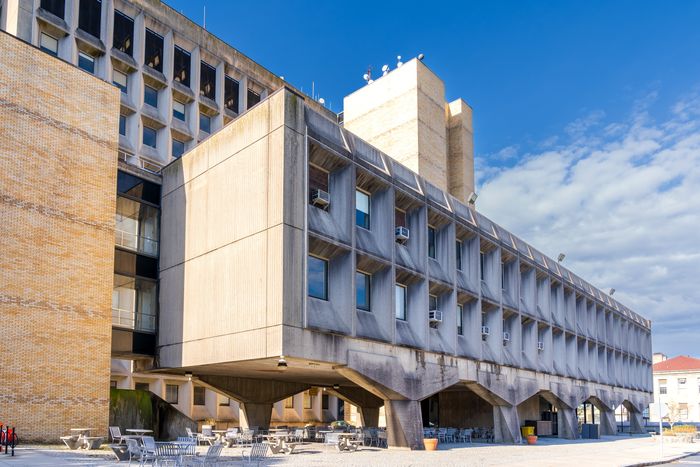
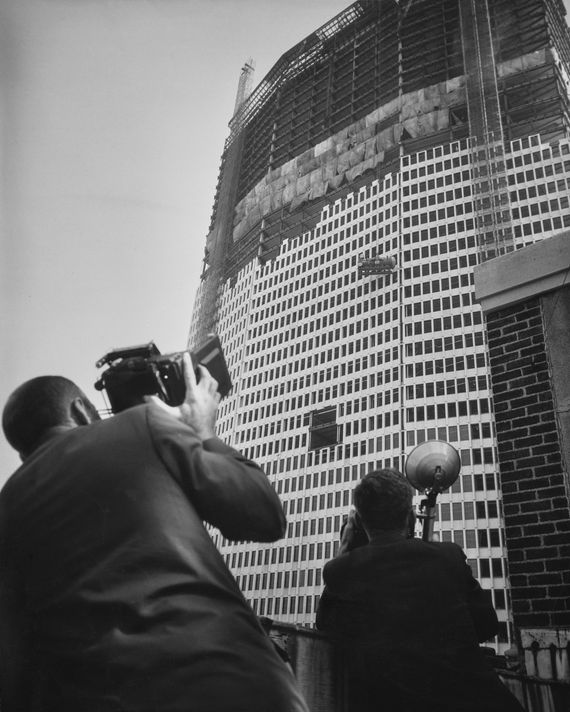
He might also have wound up building something a lot less vaguely conceived than Tóth’s Institute, which, even when we see it emerge from the earth and assume its monumental form, still looks like a balsa-wood model. Pity the fictional auteur: He can’t obsess over details — no railings, doorknobs, staircases, or windows — because the set designer, Judy Becker, didn’t provide him with any. He can’t run his hand lovingly over board-formed concrete, because the surfaces have an impossible blankness. And we never get a clear sense of what Tóth’s lifework really is, because what he designs is less a building than what Donald Trump might call a concept of a plan.
At some level, the filmmakers may have been aware that they were asking architecture in general, and Brutalism in particular, to shoulder an impossible narrative burden — to stand in for (and against) prejudice, snobbery, sexual violence, rapacious capitalism, cultural chauvinism, the memorialization of genocide and indifference to it, plus another handful of abstract themes. Rather than sort through that pile of signifiers, they just skip ahead a few decades to the first Architecture Biennale in Venice in 1980, by which time, our Lászlo is a wheelchair-bound sage. Some stock footage of the Piazza San Marco establishes location, and then we’re indoors in an exhibition hall, where a niece takes the mic to honor his life’s work. Coming in the final minutes of a three-and-a-half-hour film, this summation feels like a perfunctory flicker of hopefulness in an otherwise bitter film. I can imagine another, more consistent epilogue: a montage of Brutalist buildings being demolished. Then the film would wind up being about something specific: the vanity of building for the ages, of thinking so intently about the future that you forget how little you will matter to it at all.


